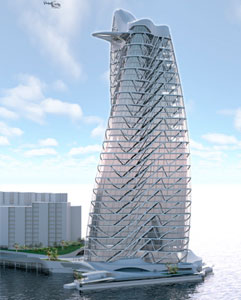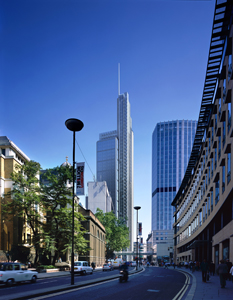by: Daniel Fox
Event: Architecture: Designs for Living – Environmental Design
Location: Center for Architecture, 05.12.08
Speakers: Paul Stoller, LEED AP — Director, Atelier Ten; Julia Nelson, AIA, LEED AP — Partner, BKSK Architects; Christopher Stoddard, AIA — Project Manager, Kohn Pedersen Fox
Moderator: Ernest Hutton, FAICP, Assoc. AIA — Principal, Hutton Associates
Organizer: AIANY Committee on the Environment (COTE); New York Visions
Sponsors: Champion: Studio Daniel Libeskind; Supporters: Gensler; Humanscale; James McCullar & Associates; Friends: Benjamin Moore & Co.; Costas Kondylis & Partners; Forest City Ratner Companies; Frank Williams & Associates; Hugo S. Subotovsky Architects; Ingram Yuzek Gainen Carroll & Bertolotti; Mancini Duffy; Magnusson Architecture and Planning; Rawlings Architects; RicciGreene Associates; Skidmore, Owings & Merrill; Syska Hennessy Group; Trespa North America; Universal Contracting Group; Contributors: Anchin, Block & Anchin; Calvin Tsao, FAIA; Cosentini Associates; Cross Construction Company; DeLaCour Ferrara Architects; Domenech Hicks Krockmalnic Architects; FXFOWLE Architects; Goldfinger Foundaiton for the Visual Arts; Helpern Architects; IBEC Development; Levien & Company; Michael Zenreich, AIA; Monadnock/Capsys; New York Building Congress; Perkins Eastman; Plaza Construction; Porter & Yee Associates; Robert A.M. Stern Architects; Roberta Washington, Architect; Rothzeid Kaiserman Thomson & Bee; Shen Milsom & Wilke; Skanska USA; Strategic Development & Construction; Swanke Hayden Connell Architects; Theo David Architects; Thornton-Tomasetti; Weidlinger Associates
Sustainable design must mitigate the effects of sun, wind, and precipitation, according to Paul Stoller, LEED AP, director at Atelier Ten. Buildings should work more so their systems work less. By designing and developing a variety of projects, the firm is able to compare how the natural environment impacts a building, and through cost analysis it can find the best ways to reduce energy consumption. For example, the Strata Tower in Abu Dhabi, designed by Asymptote with Atelier Ten acting as the environmental design consultant, a double-curved sun-shading system wraps the building maximizing views and shading in the desert climate. See In The News for more information about the tower.
Stoller spoke as part of a panel to determine whether sustainable design focuses on alleviating climate conditions, advocates for green activism, or condemns urban sprawl. Other members of the panel discussing environmental designs revealed different approaches.
For Julie Nelson, AIA, LEED AP, partner at BKSK Architects, heightening one’s experience of nature will make him or her fully realize the importance of environmental stewardship. At the Queen’s Botanical Gardens in Flushing, Queens, ecological strategies directly engage the occupants. The building peels up from the ground creating a green roof. Rainwater is captured on the large planes and directed to an apex where it falls into an open pool. Plants naturally cleanse the water before it is stored in a cistern for re-use. Visitors enter the building via a pedestrian bridge, connecting them both visually and acoustically to the running water.
Tall buildings can provide the density needed in a time of massive urban growth, believes Christopher Stoddard, AIA, project manager at Kohn Pedersen Fox. The Heron Tower, for example, will be London’s tallest building when complete. It seeks to maximize efficiency and flexibility over time. The design features a side-oriented core on the south side, shielding the interiors from the day’s harshest sun. East and west façades incorporate triple-glazed wall systems with automatic shading. A series of three-story, vertical atria on the north side of the building defines smaller “villages” within the larger building mass. Each village has an independent HVAC system that can be changed out as technology improves, and the client can reclaim the space if needed. Calculations predict an overall 34% carbon-dioxide reduction.
All three speakers touched on how the overall energy efficiency of American cities, including NYC, pale in comparison to those in Europe. U.S.-based firms must look at all aspects of green design and learn from existing models.
Tyler Caine, LEED AP, is a designer at Cook + Fox Architects.










